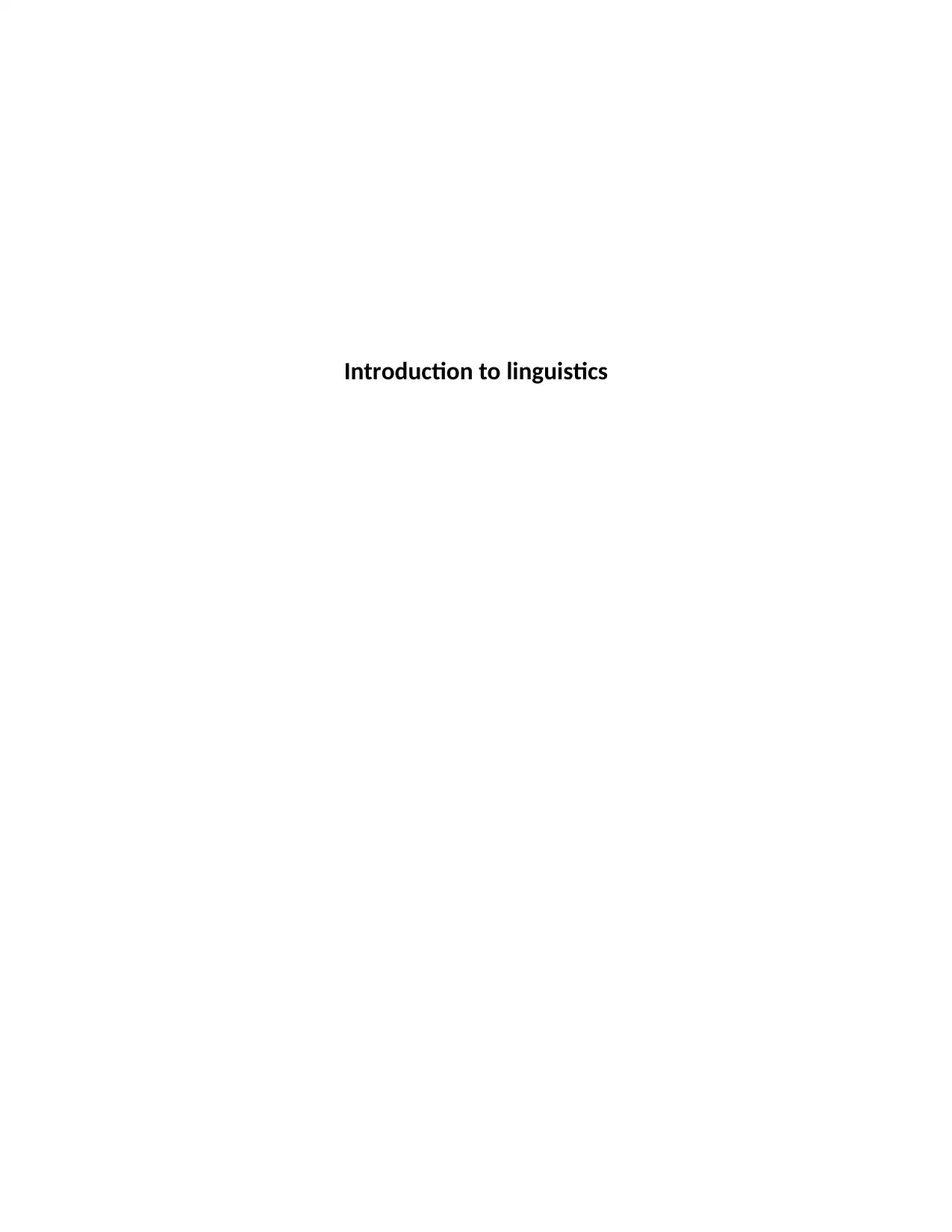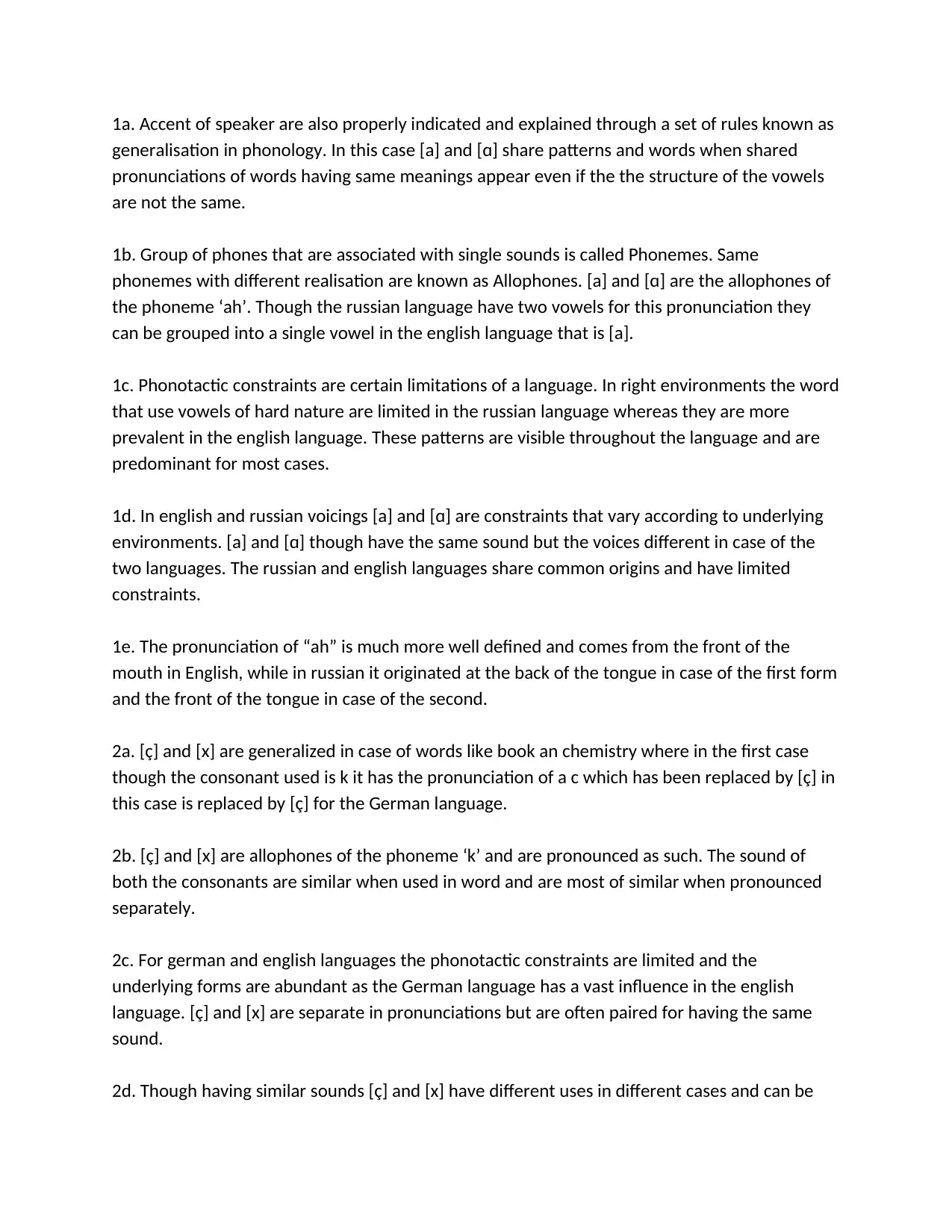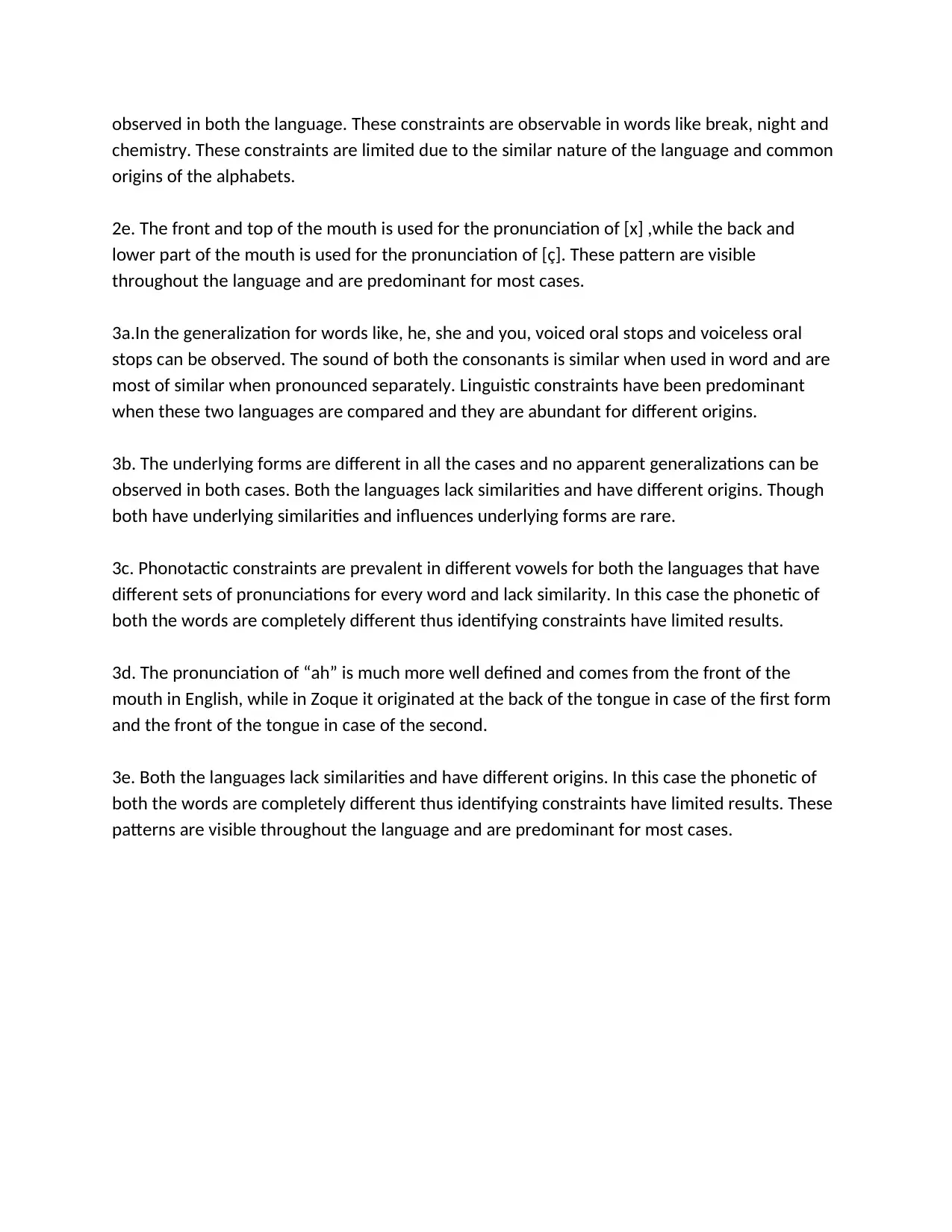LING 210 - Linguistics: Phonological Rule Derivation & Constraint
VerifiedAdded on 2023/04/20
|3
|813
|83
Homework Assignment
AI Summary
This assignment solution delves into the analysis of phonetics and phonology across different languages, specifically focusing on Russian, German, and Zoque in comparison to English. It addresses concepts such as allophones, phonemes, phonotactic constraints, and the derivation of phonological rules based on articulatory features and IPA symbols. The solution provides generalizations about sound distributions, identifies phonemes and their allophones, states phonotactic constraints, and formulates rules for underlying form changes, offering a detailed exploration of linguistic principles. Desklib is a platform where students can find similar solved assignments and study tools.

Introduction to linguistics
Paraphrase This Document
Need a fresh take? Get an instant paraphrase of this document with our AI Paraphraser

1a. Accent of speaker are also properly indicated and explained through a set of rules known as
generalisation in phonology. In this case [a] and [ɑ] share patterns and words when shared
pronunciations of words having same meanings appear even if the the structure of the vowels
are not the same.
1b. Group of phones that are associated with single sounds is called Phonemes. Same
phonemes with different realisation are known as Allophones. [a] and [ɑ] are the allophones of
the phoneme ‘ah’. Though the russian language have two vowels for this pronunciation they
can be grouped into a single vowel in the english language that is [a].
1c. Phonotactic constraints are certain limitations of a language. In right environments the word
that use vowels of hard nature are limited in the russian language whereas they are more
prevalent in the english language. These patterns are visible throughout the language and are
predominant for most cases.
1d. In english and russian voicings [a] and [ɑ] are constraints that vary according to underlying
environments. [a] and [ɑ] though have the same sound but the voices different in case of the
two languages. The russian and english languages share common origins and have limited
constraints.
1e. The pronunciation of “ah” is much more well defined and comes from the front of the
mouth in English, while in russian it originated at the back of the tongue in case of the first form
and the front of the tongue in case of the second.
2a. [ç] and [x] are generalized in case of words like book an chemistry where in the first case
though the consonant used is k it has the pronunciation of a c which has been replaced by [ç] in
this case is replaced by [ç] for the German language.
2b. [ç] and [x] are allophones of the phoneme ‘k’ and are pronounced as such. The sound of
both the consonants are similar when used in word and are most of similar when pronounced
separately.
2c. For german and english languages the phonotactic constraints are limited and the
underlying forms are abundant as the German language has a vast influence in the english
language. [ç] and [x] are separate in pronunciations but are often paired for having the same
sound.
2d. Though having similar sounds [ç] and [x] have different uses in different cases and can be
generalisation in phonology. In this case [a] and [ɑ] share patterns and words when shared
pronunciations of words having same meanings appear even if the the structure of the vowels
are not the same.
1b. Group of phones that are associated with single sounds is called Phonemes. Same
phonemes with different realisation are known as Allophones. [a] and [ɑ] are the allophones of
the phoneme ‘ah’. Though the russian language have two vowels for this pronunciation they
can be grouped into a single vowel in the english language that is [a].
1c. Phonotactic constraints are certain limitations of a language. In right environments the word
that use vowels of hard nature are limited in the russian language whereas they are more
prevalent in the english language. These patterns are visible throughout the language and are
predominant for most cases.
1d. In english and russian voicings [a] and [ɑ] are constraints that vary according to underlying
environments. [a] and [ɑ] though have the same sound but the voices different in case of the
two languages. The russian and english languages share common origins and have limited
constraints.
1e. The pronunciation of “ah” is much more well defined and comes from the front of the
mouth in English, while in russian it originated at the back of the tongue in case of the first form
and the front of the tongue in case of the second.
2a. [ç] and [x] are generalized in case of words like book an chemistry where in the first case
though the consonant used is k it has the pronunciation of a c which has been replaced by [ç] in
this case is replaced by [ç] for the German language.
2b. [ç] and [x] are allophones of the phoneme ‘k’ and are pronounced as such. The sound of
both the consonants are similar when used in word and are most of similar when pronounced
separately.
2c. For german and english languages the phonotactic constraints are limited and the
underlying forms are abundant as the German language has a vast influence in the english
language. [ç] and [x] are separate in pronunciations but are often paired for having the same
sound.
2d. Though having similar sounds [ç] and [x] have different uses in different cases and can be

observed in both the language. These constraints are observable in words like break, night and
chemistry. These constraints are limited due to the similar nature of the language and common
origins of the alphabets.
2e. The front and top of the mouth is used for the pronunciation of [x] ,while the back and
lower part of the mouth is used for the pronunciation of [ç]. These pattern are visible
throughout the language and are predominant for most cases.
3a.In the generalization for words like, he, she and you, voiced oral stops and voiceless oral
stops can be observed. The sound of both the consonants is similar when used in word and are
most of similar when pronounced separately. Linguistic constraints have been predominant
when these two languages are compared and they are abundant for different origins.
3b. The underlying forms are different in all the cases and no apparent generalizations can be
observed in both cases. Both the languages lack similarities and have different origins. Though
both have underlying similarities and influences underlying forms are rare.
3c. Phonotactic constraints are prevalent in different vowels for both the languages that have
different sets of pronunciations for every word and lack similarity. In this case the phonetic of
both the words are completely different thus identifying constraints have limited results.
3d. The pronunciation of “ah” is much more well defined and comes from the front of the
mouth in English, while in Zoque it originated at the back of the tongue in case of the first form
and the front of the tongue in case of the second.
3e. Both the languages lack similarities and have different origins. In this case the phonetic of
both the words are completely different thus identifying constraints have limited results. These
patterns are visible throughout the language and are predominant for most cases.
chemistry. These constraints are limited due to the similar nature of the language and common
origins of the alphabets.
2e. The front and top of the mouth is used for the pronunciation of [x] ,while the back and
lower part of the mouth is used for the pronunciation of [ç]. These pattern are visible
throughout the language and are predominant for most cases.
3a.In the generalization for words like, he, she and you, voiced oral stops and voiceless oral
stops can be observed. The sound of both the consonants is similar when used in word and are
most of similar when pronounced separately. Linguistic constraints have been predominant
when these two languages are compared and they are abundant for different origins.
3b. The underlying forms are different in all the cases and no apparent generalizations can be
observed in both cases. Both the languages lack similarities and have different origins. Though
both have underlying similarities and influences underlying forms are rare.
3c. Phonotactic constraints are prevalent in different vowels for both the languages that have
different sets of pronunciations for every word and lack similarity. In this case the phonetic of
both the words are completely different thus identifying constraints have limited results.
3d. The pronunciation of “ah” is much more well defined and comes from the front of the
mouth in English, while in Zoque it originated at the back of the tongue in case of the first form
and the front of the tongue in case of the second.
3e. Both the languages lack similarities and have different origins. In this case the phonetic of
both the words are completely different thus identifying constraints have limited results. These
patterns are visible throughout the language and are predominant for most cases.
⊘ This is a preview!⊘
Do you want full access?
Subscribe today to unlock all pages.

Trusted by 1+ million students worldwide
1 out of 3
Your All-in-One AI-Powered Toolkit for Academic Success.
+13062052269
info@desklib.com
Available 24*7 on WhatsApp / Email
![[object Object]](/_next/static/media/star-bottom.7253800d.svg)
Unlock your academic potential
Copyright © 2020–2025 A2Z Services. All Rights Reserved. Developed and managed by ZUCOL.
